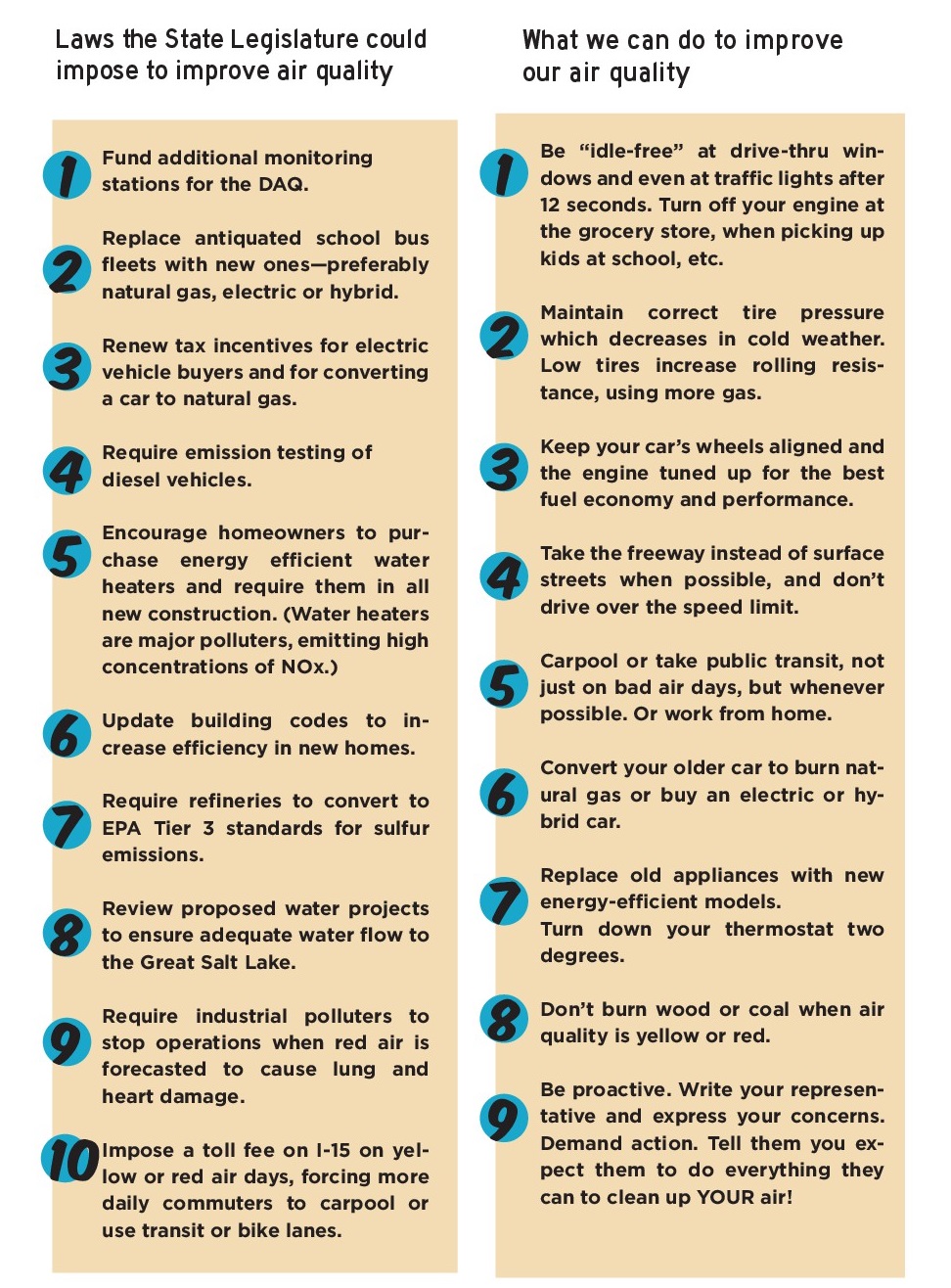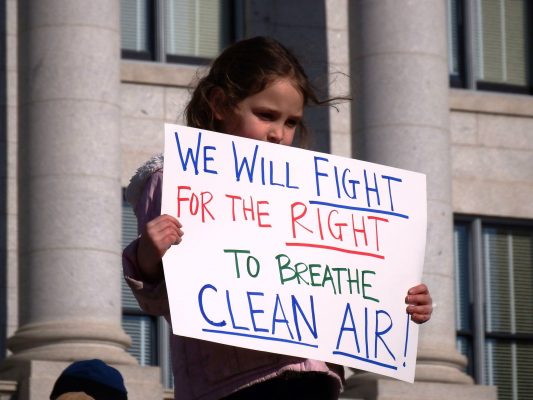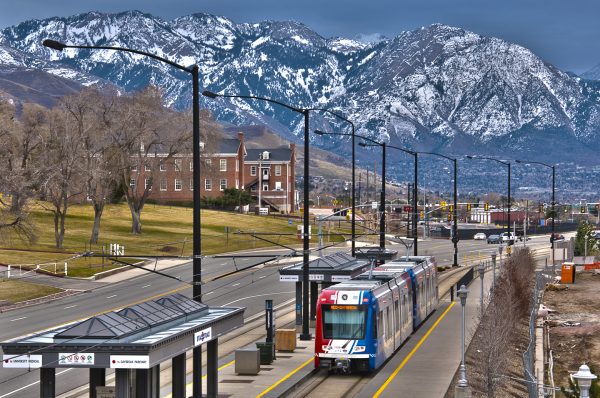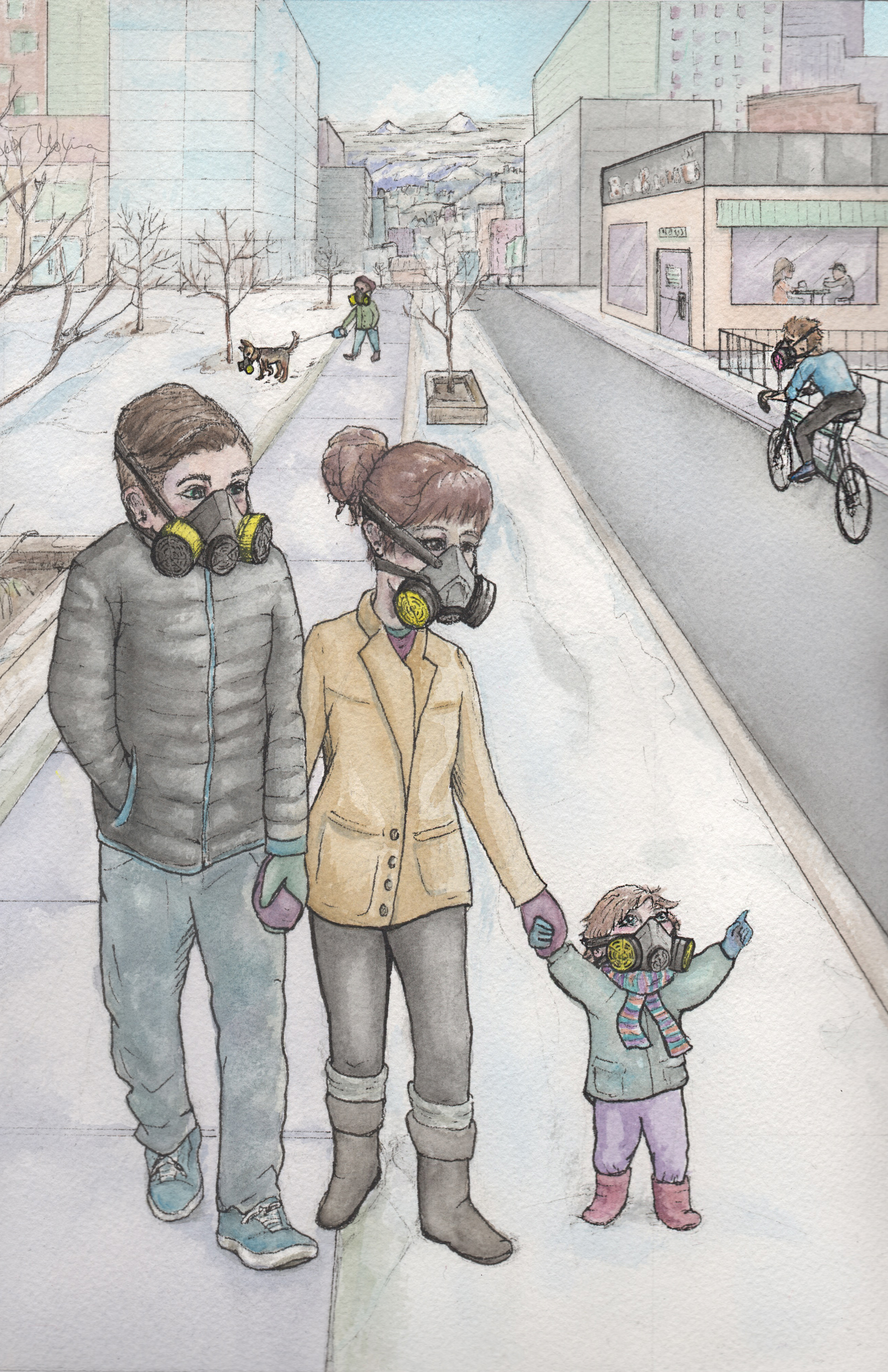
Capitol Hill—Protesters are chanting the same mantra they have chanted for the past several years:
“What do we want?”
“Clean air!”
“When do we want it?”
“Now!”
On a snow-bombed Saturday in January, a coalition of clean air advocates hosted the 4th Annual Clean Air, No Excuses rally at the State Capitol, where eight hundred protesters braved the cold to make their voices heard.
Year after smoggy year, passionate advocates, concerned parents and teachers, children with asthma and other bronchial conditions, even doctors, converge on the capitol steps to demand action from an ambivalent group of lawmakers.
Utahns want clean air, so why isn’t it happening?
The Building Boom
Governor Herbert loves to boast about Utah’s booming economy and how our population is now the fastest-growing in the nation. This is due more to internal growth than from in-migration. With large families wanting more square footage, the majority of growth is occurring in the suburbs where the ever-widening freeway corridors and massive amounts of vehicular traffic create 37% of the problem. Another 15% is the result of diesel engines in semi-trucks which supply the population with goods.
The endless frenzy to build places an ever-increasing burden on the air shed in our mountain basins and poses a growing threat to the health and well-being of valley residents.
The Wasatch Front’s unprecedented growth sacrifices farmland and greenspace for the higher revenue-producing glut of strip malls and cookie-cutter subdivisions, and the perpetual widening of I-15 and its arterial corridors only enhances traffic congestion and increases emissions. Private automobiles are by far the biggest sources of noxious emissions, and more roads equal more cars. We will always overwhelm the available infrastructure, because if we build it, they will come.
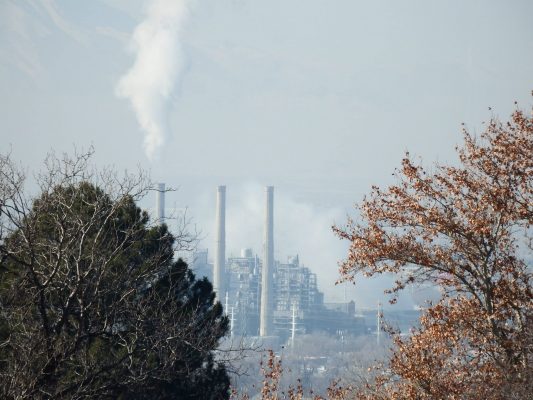
Industrial Polluters
Studies vary, but the Utah Clean Air Partnership, known as UCAIR, claims that large super polluters like Kennecott (Rio Tinto), Stericycle, MagCorp, PacifiCorp, Tesoro and HollyFrontier refineries, and Geneva Rock contribute only 11% of Utah’s dangerous air, while homes and businesses are responsible for 39%, with transportation—primarily private automobiles—leading the way as the real smog monsters at roughly 50%. And it isn’t just emissions and smoke. Airborne dust from gravel pits and construction projects also fill the air with lung-contaminating particulates, some of which contain cancer-causing chemicals. Wind-blown sediments from a receding Great Salt Lake are also a concern.
To its credit, Geneva Rock recently spent $8 million dollars on 25 new compressed natural gas cement trucks and an on-site refueling station. While it won’t reduce airborne dust, the new fleet is expected to have the same effect as removing 8,000 cars from Utah’s roads annually.
Another study implicates Kennecott as spewing a full one-third of the pollution in the Salt Lake Valley all by itself. Kennecott vehemently denies this, and the other industrial culprits downplay their roles as well. Regardless of who’s to blame, Utahns owe much of our progress toward clean air to federal guidelines and Environmental Protection Agency enforcement rather than the abysmal standards imposed by local bureaucracies.
Coal-fired power plants produce much of our electricity, while a growing populace produces additional fossil fuel exhausts that spew from our tailpipes, chimneys and factories in ever-greater concentrations.
The Baby Steps of the Utah State Legislature
2016 was an especially contentious year for air quality issues due mostly to public demand for action from state leaders, and the 2017 legislature, which is currently in session, is expected to address the issue once again, but with fewer solutions on the table. Anticipated proposals include seeking funds to replace aging school bus fleets with newer models, and a possible renewal of tax credits for buyers of new electric vehicles.
Some much-needed funding could come in the form of a payout from the lawsuit against Volkswagen. According to Reuters, “VW admitted in 2015 to installing secret software in its diesel cars to cheat exhaust emissions tests and make them appear cleaner in testing than they really were. In reality, the vehicles emitted up to 40 times the legally allowable emissions levels.” Volkswagen lost in court and Utah’s share of the roughly $15.2 billion dollar settlement could equate to $32 million dollars in compensation to fund clean air legislation.
Why Bad Air has Such Harmful Health Consequences
Consisting of a variety of potent gases including benzene, sulfur dioxide (SO2), oxides of nitrogen (NOx), volatile organic compounds (VOC), particulate matter (especially PM 2.5) that lodges in the lungs, and ground-level ozone which occurs when various chemical elements react with sunlight, smog is a silent but visible danger. Tiny PM 2.5 particles are especially insidious, bypassing the body’s defenses and entering the bloodstream where they are responsible for a host of cardiopulmonary, cognitive and pre-natal conditions. Air pollution has even been linked to Utah’s unusually high autism rate.
Homeowners and businesses are discouraged from burning solid fuels such as wood or coal, which are especially dangerous during mandatory action periods, but a bill that would have imposed an outright ban on solid-fuel burning failed legislative approval in 2015. Lawmakers were concerned that it would impact the handful of people who rely on burning wood to heat their homes or cook their meals.
Wood burning is one of the worst things we can do, according to Dr. Brian Moench, of Utah Physicians for a Healthy Environment. “The easiest, cheapest, and least disruptive way to make the most improvement in the pollution from our winter inversions is to eliminate wood burning,” he says. “Wood smoke is far more toxic than just about any other type of pollution that the average person is ever exposed to, even more dangerous than cigarette smoke.”
As Utah’s population grows, so do its greenhouse emissions. Known cynically as Smog Lake City, Utah, Salt Lake regularly fails attainment standards for particulate matter and ozone levels during prolonged inversion periods. Watchdog groups like HEAL Utah, Utah Physicians for a Healthy Environment (UPHE), Mormon Environmental Stewardship, Purple Air, UCAIR, The Utah Clean Cities Coalition and others monitor air conditions and the state’s sometimes nebulous claims of complicity with EPA regulations, which have seen spikes of nonattainment for more than 10 years.
The Effects of Red Air
The Division of Air Quality issues “red air” alerts on high concentration days when the air is unhealthy for sensitive groups, including children, the elderly, and those with heart and lung conditions. This latter group suffers the highest risk of smog-related heart attacks and strokes. An estimated 1,000 to 2,000 Utahns die each year from exposure to dirty air, and the rest of us lose up to two years of life expectancy, according to UPHE statistics.
There are no safe levels of particulates or ozone, and many doctors correlate these compounds with an increase in health care costs due to heart and respiratory conditions, low birth weight and infant mortality in areas where concentrations are high, even for short periods.
In its 2016 Year-End Report on Air Pollution and Health Research, UPHE noted that “A landmark study showed that the Great London Smog event of 1952 was still impacting people’s health 60 years later. Those who were infants or babies in utero when they were exposed to the event (which only lasted 5 days), showed higher rates of respiratory disease measured several decades later.
“Air pollution’s connection to cancer was greatly enhanced with studies showing that children who had leukemia had significantly higher levels of pollution nanoparticles in their blood, and that rates of death from multiple types of cancer, especially breast cancer, is significantly increased with long-term levels of pollution comparable to those of the Wasatch Front.”
The report goes on to cite the correlation between smog and pregnancy complications including impaired fetal development and premature birth, and “The connection between pollution and neurodegenerative diseases, like Alzheimer’s and Parkinson’s Disease, impaired memory and cognition, behavioral disorders, mental illnesses and autism…” (You can read the full report at 2016-UPHE-Air-Pollution-Research-Report.pdf on the group’s website.)
Transit (for others) is a Huge Part of the Solution
The satirical newspaper The Onion reported in 2014 the American Public Transportation Association’s claims that 98 percent of Americans support the use of mass transit by others. APTA is kicking off a campaign to promote mass transit with the slogan, “Take The Bus… I’ll Be Glad You Did.”
Mass transit should be the obvious solution to the problem of too many cars, and to their credit, Utah politicians and the Utah Transit Authority have done an adequate job of extending light rail and Frontrunner trains to accommodate motoring suburbanites and reduce single-occupant car commutes. But when mass transit ridership is compared with commuters on the parallel I-15, the difference is disappointing.
Studies reveal that in the Salt Lake metro-area, light rail is utilized by only about 3.4% of all commuters. It’s even lower in the Ogden and Provo metro areas, whereas the national average is 5%. Most Salt Lakers and suburbanites don’t live near a Trax corridor, and only a few will drive to a Trax station to board a train once they’re already in their cars. More rail spurs into residential areas could boost ridership significantly, but with a correspondingly high infrastructure cost.
An estimated 94% of commuters drive to work alone and only 2% carpool. It’s clear that behaviors are not changing and that the only way to make transit work on a much larger scale would be to charge commuters an environmental and health deterioration fee and/or a usage fee for using the freeway for their daily commutes. This money could fund treatment of the most severe cases of asthma, bronchitis, birth defects and autism, which are more common for residents who live near freeway corridors.
In response to the sickening effects of tailpipe emissions, UCAIR and The Utah Clean Cities Coalition (UCCC) encourage drivers to be idle-free. “The average person idles their car five to ten minutes a day. Cutting idle times makes sense during inversions because reduced idling also reduces the emissions of nitrogen oxides (NOx) and volatile organic compounds (VOCs), both precursor gases for the formation of PM2.5 during inversions… More than 10 seconds of idling can use more fuel than turning off the engine and restarting it. If you are stopped for more than 10 seconds, you’ll save fuel and money by turning off the vehicle and then restarting it when you’re ready to drive away.”
Catalytic converters and fuel injectors ensure that modern vehicles are cleaner than older cars, and driving a car warms up the engine much faster than idling. Logically, it also reduces emissions and engine wear. Turning off your engine at stoplights, in parking lots, drive-thru’s, when dropping kids off at school, or anytime the car is stationary for more than 12 seconds is not only good for the air we all breathe, it also saves gas. As an added bonus, not “warming up” your car when you’re not in it reduces the chance of it being stolen.
Salt Lake City, Park City, and Holladay have established ordinances against unnecessary vehicle idling for more than two minutes. The ordinance does not apply to vehicles in private driveways, and enforcement is difficult at best, placing the burden of complicity on responsible citizens. Signs in Salt Lake City remind drivers to “Turn your key, be idle-free,” but violators receive three warnings before being cited, making the ordinance hard to take seriously.
Salt Lake County has developed an extensive and convenient network of bike paths to promote cycling as an alternative method of commuting. However, as air quality decreases, car use increases, even in warm weather. Physical exertion during an inversion or when ozone levels are high isn’t safe, turning a partial solution into a Catch-22.
The Economic Costs of Red Air
Smog acts like an economic sanction on a city. Even our billion-dollar ski industry is affected, with a significant number of out-of-state skiers opting for the crystalline skies of Colorado when the Salt Lake valley is blanketed in smog—a word that is never uttered by our local weather people. They prefer the term “haze,” as though it was somehow benign.
In addition, our toxic air has caused companies looking to anchor here to turn tail and run, taking their tax dollars with them, solely because of our inversions and their threats to human health. An increase in sick days affects employers, and medical experts see a rise in mental health issues like Seasonal Affective Disorder (SAD), a form of depression caused by a lack of sunlight, as well an uptick in Utah’s already high suicide rate during lengthy inversions.
A Bigger Health Crisis than Red Air? Really?
Despite the undisputed effects of air pollution, Senator Todd Weiler, with the endorsement of Governor Gary Herbert, stated in April of last year that pornography (yes, pornography) “perpetuates a sexually toxic environment” and declared pornography—not air pollution—to be a public health crisis. There was no mention of the life-threatening effects of toxic air on their constituents’ health, and no public declaration to do anything about it. Such a morally obtuse set of priorities should make us question the motives of our elected representatives. To view porn or not is a choice, whereas breathing clean air is an inherent right of people everywhere.
If we follow the money trail (and you can at www.followthemoney.org and opensecrets.org), Utah lawmakers are beholden to a bevy of special interest groups and industry insiders who fund their campaigns in an attempt to stifle green economic growth and keep us entrenched in a 19th Century energy protocol, including the most archaic and dirty fossil fuel of all—coal—which is actually a more expensive energy source than many renewable sources. Coal seam extraction leaves permanently devastated and contaminated landscapes, while much of the actual coal would be extracted by foreign corporations and shipped abroad to darken distant skies.
What About the Future?
If Utah politicians were truly concerned about public health, they would cease their chronic capitulation to the dirty energy industry and big polluters, and instead, allocate subsidies for the green energy sources that will take Utah into a future of blue skies and green living for all of her citizens.
There are no quick fixes for Utah’s chunky air. Even a suddenly strict enforcement of existing clean air laws along with stiffer penalties for corporate polluters would have a negligible effect on our air in the face of continued growth and the unwillingness of most people to change their commuting habits. It will take a collaborative effort on the part of government and an informed citizenry to achieve real change.
We all enjoy the ease and convenience of our comfortable lifestyles, but at what cost to our health? If you drive a car, live in a house, or purchase consumer goods, you’re part of the problem. We’re all a part of the problem. We can also be a part of the solution.
If you’re looking for a quick fix to our air dilemma, holding your breath isn’t the answer. Take action. Do your part and set an example for others. If we all do a little, together we can do a lot. By taking individual action, we could all breathe a little easier.
